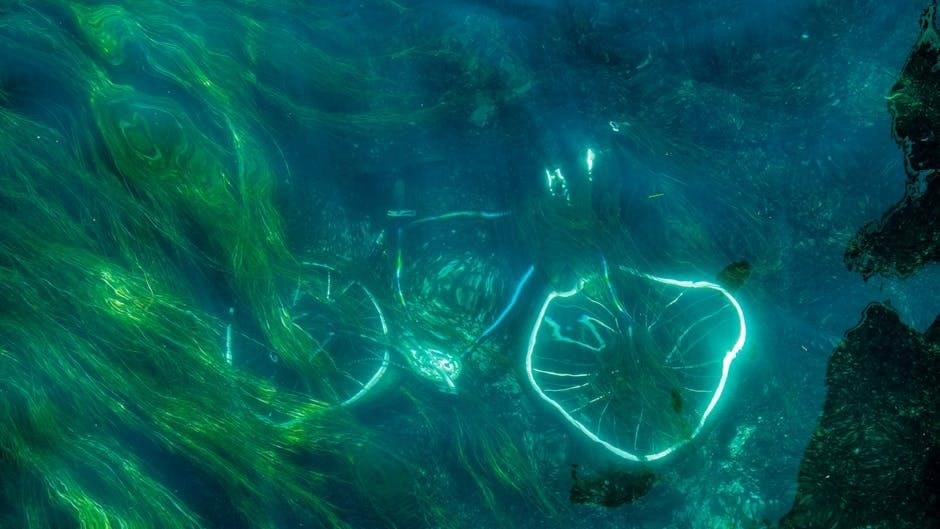Understanding the Water Cycle Worksheet PDF
A PDF worksheet provides a comprehensive guide to the water cycle, including answers to questions about processes like evaporation, condensation, and precipitation. It serves as a valuable teaching resource for students, helping clarify concepts through diagrams and labeled examples. The worksheet reinforces understanding of cloud formation, transpiration, and accumulation, ensuring students grasp the cycle’s essential elements.
- Evaporation explained through real-world examples
- Cloud formation and precipitation types detailed
- Accumulation and runoff processes clarified
This structured approach ensures students can confidently answer quiz questions and apply their knowledge effectively.

What is the Water Cycle?
The water cycle is a continuous natural process involving evaporation, condensation, precipitation, accumulation, and runoff. It redistributes water across Earth, supporting ecosystems and weather patterns. Understanding these stages is essential for grasping how water sustains life.
- Evaporation: Water turns into vapor from surfaces
- Condensation: Vapor forms clouds
- Precipitation: Water falls as rain, snow, or hail
- Accumulation: Water collects in bodies like rivers
- Runoff: Water flows back to oceans and lakes
Primary Processes in the Water Cycle
The primary processes in the water cycle are essential for understanding how water moves and circulates around the Earth. These processes include evaporation, transpiration, condensation, precipitation, and runoff.

Evaporation: This is the process where water from the Earth’s surface, such as oceans, lakes, and rivers, is heated by the sun and turns into water vapor. This vapor rises into the atmosphere.
Transpiration: Similar to evaporation, transpiration occurs when water is released into the atmosphere from plants through their leaves. This process contributes to the overall water vapor in the air.
Condensation: As water vapor in the atmosphere cools, it condenses into tiny droplets, forming clouds. This process is crucial for the development of precipitation.

Precipitation: When clouds become too heavy with water droplets, the water falls back to the Earth’s surface as rain, snow, sleet, or hail.
Runoff: After precipitation, water flows over the land and eventually returns to bodies of water such as rivers, lakes, and oceans, completing the cycle.
These processes work together to maintain the balance of water on Earth, ensuring a continuous supply for ecosystems and human use.
Evaporation and Its Role
Evaporation is the process by which water transitions from its liquid state to water vapor, playing a crucial role in the water cycle. It occurs when heat from the sun acts on bodies of water, such as oceans, lakes, and rivers, causing the surface water to evaporate into the air. This process is essential for maintaining the Earth’s water balance, as it feeds the atmosphere with water vapor that eventually condenses to form clouds.
- Evaporation cools the Earth’s surface, providing a natural temperature regulation system.
- It is most active in warm, sunny, and windy conditions, where water loss from surfaces is rapid.
- Evaporation helps replenish atmospheric moisture, enabling precipitation to occur in other regions.
Understanding evaporation is key to grasping how water circulates continuously, ensuring the availability of fresh water for ecosystems and human needs.

Condensation Explained
Condensation is a key process in the water cycle where water vapor in the atmosphere cools and transforms back into liquid droplets. This occurs when warm, moist air rises, cools, and loses heat, causing water vapor to condense around tiny particles in the air. This process forms clouds, seen as visible masses of water droplets or ice crystals suspended in the atmosphere.
- Condensation plays a critical role in redistributing water, as it gathers water vapor into larger droplets that eventually fall as precipitation.
- Clouds act as temporary storage for condensed water, influencing weather patterns and climate.
- Without condensation, the cycle of water returning to Earth would not occur, making it vital for sustaining ecosystems and freshwater supplies.
By studying condensation, students gain insight into how water vapor is recycled, ensuring the continuity of the water cycle and supporting life on Earth.
Precipitation Types and Impact
Precipitation is a vital process in the water cycle, referring to the falling of water droplets, ice crystals, or other frozen particles from the atmosphere to the Earth’s surface. There are several types of precipitation, each with distinct characteristics and impacts:
- Rain: Liquid droplets falling from clouds, contributing to surface and groundwater recharge. Excessive rain can lead to flooding, while prolonged droughts result from insufficient rainfall.
- Snow: Frozen precipitation that accumulates, providing water storage in snowpacks. Melting snow replenishes rivers and supports ecosystems in spring.
- Sleet: Raindrops that freeze before reaching the ground, creating slippery conditions and posing hazards for transportation.
- Hail: Ice pellets formed in strong thunderstorms, damaging crops, property, and posing safety risks during severe storms.
Precipitation plays a crucial role in maintaining ecosystems, supporting agriculture, and sustaining human activities. It ensures water availability for drinking, irrigation, and industrial use; Understanding precipitation types and their impacts is essential for grasping the water cycle and its significance in sustaining life on Earth.
Accumulation and Runoff
In the water cycle, accumulation refers to the gathering of water in various bodies such as lakes, rivers, and oceans, while runoff involves the movement of water over land towards these bodies. Surface runoff occurs when water flows over land, often contributing to erosion. Additionally, groundwater runoff involves water seeping into the soil and flowing underground, replenishing water supplies. Accumulation is essential for maintaining water levels in reservoirs and wetlands, supporting ecosystems and human activities. Runoff helps distribute water to different regions, aiding agriculture and drinking water supplies. Together, accumulation and runoff play crucial roles in ensuring water availability and maintaining the balance of the water cycle.
- Surface Runoff: Water flows over land, contributing to erosion and transporting sediment.
- Groundwater Runoff: Water seeps into soil, replenishing underground water supplies.
- Accumulation: Water collects in bodies like lakes and rivers, essential for ecosystems and human use.
These processes are vital for sustaining life and ecosystems by ensuring water distribution and availability. Understanding accumulation and runoff is key to grasping the water cycle and its importance in nature.

Water Cycle Worksheet: Key Concepts
This worksheet covers essential aspects of the water cycle, such as cloud formation, transpiration, and labeling the water cycle diagram. It helps students understand the processes involved in the water cycle and how they interact. Key concepts include:
- Cloud Formation: Understanding how water droplets come together to form clouds
- Transpiration:The process by which water moves through plants and evaporates from leaves
- Labeling Diagrams:Identifying key stages of the water cycle in visual representations
Students can apply this knowledge to answer quiz questions and complete activities related to the water cycle.
Cloud Formation and Water Droplets
Clouds are formed when water droplets in the atmosphere come together. This process begins with evaporation, where water from Earth’s surfaces turns into vapor and rises into the air. As this vapor moves upward, it cools and condenses, forming tiny water droplets that gather to make clouds. These droplets are so small that they can float in the sky, creating the fluffy shapes we see.
In the worksheet, you might be asked to explain how these droplets form or identify the stages of cloud development. Understanding this helps you connect evaporation and condensation in the broader water cycle. Remember, clouds are crucial for precipitation, as they release water back to the Earth when they become too heavy.
Key points about cloud formation include:
- Formation relies on water vapor cooling and condensing.
- Clouds are made up of countless tiny water droplets.
- Cloud types vary based on altitude and droplet size.
This knowledge will help you answer questions related to cloud formation and water droplets accurately in the worksheet.
Transpiration:

Transpiration is a vital process within the water cycle, where water is carried upwards through plants from the roots to the leaves, and then evaporates into the atmosphere. This process is closely linked to evaporation and plays a crucial role in maintaining the balance of water and energy in ecosystems. Transpiration helps plants absorb water from the soil and nutrients necessary for their growth and photosynthesis.
In the context of the water cycle worksheet, you might encounter questions that ask you to explain the steps of transpiration or its significance. Understanding this process will allow you to see how it connects with other stages like evaporation, condensation, and precipitation, forming a continuous cycle that sustains life on Earth.
For instance, did you know that approximately 10% of the moisture in the atmosphere comes from transpiration? This process contributes significantly to the overall water cycle, ensuring that water is continuously recycled through different phases and environments. The worksheet may also include diagrams or questions that require you to label the stages of transpiration, helping reinforce your understanding of this essential natural process.
By studying transpiration, you gain insight into how plants and the environment work together to maintain the delicate balance necessary for life. This knowledge is not only beneficial for completing your worksheet but also for appreciating the intricate workings of nature.
Labeling the Water Cycle Diagram
Labeling the water cycle diagram is a fundamental exercise that helps students visualize and understand the various stages of the water cycle. By assigning appropriate terms to each step in the diagram, students reinforce their knowledge of processes like evaporation, condensation, precipitation, accumulation, and runoff. This activity also enhances retention and clarity, as it combines visual learning with critical thinking.
In the worksheet, students may be provided with a blank diagram of the water cycle and a list of key terms to label. For example, evaporation is the process where water transforms from liquid to vapor, while condensation involves water vapor cooling and forming droplets. Precipitation occurs when these droplets combine and fall back to Earth, whether as rain, snow, or other forms.
For instance, students might label the sun as a key driver of evaporation, clouds as the stage where condensation occurs, and a river or ocean as the accumulation or runoff stage. This hands-on approach ensures students grasp the interconnectedness of each process within the cycle.
By completing this labeling exercise, students gain a clearer understanding of how the water cycle operates and its importance in sustaining life on Earth. It also prepares them to answer related quiz questions with confidence, solidifying their comprehension of this essential natural process.

Water Cycle Worksheet Answer Key
The answer key provides correct answers to water cycle questions, covering stages like evaporation, condensation, precipitation, and runoff, assisting students in learning effectively.
Answers to Common Questions
The water cycle worksheet provides answers to common questions about the processes involved in the cycle. For example, when asked about the role of evaporation, the worksheet explains how water transitions from liquid to vapor due to heat. Similarly, condensation is described as the process by which water vapor cools and forms droplets in clouds. Precipitation is identified as the falling of water from clouds in the form of rain, snow, or hail. Accumulation refers to the collection of water in bodies like rivers, lakes, or oceans, completing the cycle. The worksheet also clarifies transpiration, where water evaporates from plant leaves. By addressing these key concepts, students gain a deeper understanding of the water cycle’s essential processes. Additionally, the answer key helps identify common mistakes, ensuring accuracy in learning.
– Evaporation: Water turning into vapor
– Condensation: Water vapor forming droplets
– Precipitation: Rain, snow, or hail falling
– Accumulation: Water gathering in bodies
– Transpiration: Water evaporating from plants
Understanding Quiz Questions
The quiz questions in the water cycle worksheet are designed to test students’ knowledge of the processes involved in the cycle; Questions focus on identifying key terms like evaporation, condensation, and precipitation, as well as understanding their roles within the cycle. For example, students might be asked to explain how water vapor transforms back into liquid form during condensation. They may also be required to label diagrams, identify the stages of the water cycle, or explain cloud formation and precipitation types. Understanding these concepts ensures students can accurately complete the worksheet and apply their knowledge in real-world scenarios. The quiz format encourages critical thinking and reinforces learning. Common mistakes include confusing evaporation with condensation or mislabeling diagram components. By carefully reviewing the answer key, students can improve their understanding and avoid errors.
- Key concepts: Evaporation, condensation, precipitation
- Cloud formation and water droplets explained
- Precipitation types: Rain, snow, hail
- Importance of labeling diagrams
Processes of the Water Cycle: Quiz Answers
Understanding the processes of the water cycle is essential for answering quiz questions accurately. Evaporation occurs when water transforms from liquid to vapor, often from oceans, lakes, or rivers. Condensation is the process where water vapor cools and forms tiny droplets, creating clouds. Precipitation happens when these droplets combine and fall back to Earth as rain, snow, or hail. Accumulation refers to the collection of water in bodies like rivers or glaciers. Runoff is when water flows over land into these bodies. Transpiration is when water vapor is released into the atmosphere by plants. Each process plays a vital role in sustaining Earth’s water supply and climate. Answering quiz questions about these processes requires clear understanding and precise definitions. This ensures students can confidently explain the water cycle’s workings and its importance in ecosystems.
- Evaporation: Heat turns water into vapor
- Condensation: Vapor forms clouds
- Precipitation: Water falls to Earth
- Accumulation: Water collects in bodies
- Runoff: Water flows to bodies
- Transpiration: Plants release water
These steps are interconnected, maintaining the Earth’s water balance and supporting life. Answering quiz questions correctly demonstrates mastery of these concepts.
Cloud Formation and Precipitation: Quiz Answers
Cloud formation and precipitation are critical components of the water cycle. Clouds form when water vapor condenses into tiny droplets, gathering in the atmosphere. Precipitation occurs when these droplets grow heavy and fall to Earth as rain, snow, or hail. Understanding these processes helps students explain how water moves through the cycle.
- Clouds are built from water droplets
- Precipitation types include rain and snow
- Accumulation occurs after precipitation
- Runoff carries water to bodies
Quiz answers should clarify that clouds result from condensation and precipitation is water falling back to Earth. This knowledge is essential for grasping the water cycle’s role in sustaining ecosystems. Precise answers demonstrate mastery of these key concepts.

Water Cycle Worksheet PDF: Detailed Explanation
This worksheet provides a comprehensive explanation of the water cycle, focusing on key processes such as evaporation, condensation, and precipitation.
- Step-by-step details on cloud formation
- Types of precipitation and their impacts
- Runoff and accumulation explained clearly
It serves as an essential tool for educators to reinforce students’ understanding of the water cycle’s intricate processes.
Worksheet Purpose and Use
The water cycle worksheet is designed to reinforce students’ understanding of this fundamental natural process. It serves as a practical tool for educators to enhance learning objectives by breaking down the cycle into manageable concepts. Key processes like evaporation, condensation, precipitation, and accumulation are clearly explained, ensuring students grasp the interconnectedness of each step. The worksheet also includes labeling diagrams and answering questions, helping students apply their knowledge in hands-on activities. Its purpose is to make complex scientific principles accessible and engaging, fostering a deeper comprehension of how water moves through Earth’s ecosystems. Educators can use it to supplement lessons, assess student understanding, or provide additional practice. This resource is compatible across various grade levels, making it adaptable for diverse learning needs. By focusing on active learning, the worksheet empowers students to visualize and articulate the water cycle effectively, bridging theory and application.
Downloading the Worksheet PDF
The water cycle worksheet is available for download in PDF format, making it easy to access and print. Educators and students can obtain the worksheet from reputable educational websites or platforms offering free resources. Once downloaded, the PDF file includes a detailed diagram of the water cycle, labeled with key processes such as evaporation, condensation, precipitation, and accumulation. Additionally, the worksheet features questions and answers to test understanding, ensuring users can apply their knowledge effectively.
- Downloadable PDF format for easy access
- Includes labeled diagrams and detailed explanations
- Features questions and answers for comprehensive learning
Users can also download the worksheet as a text file or read it online, providing flexibility in how they engage with the material. This resource is ideal for reinforcing lessons and helping students visualize the water cycle’s processes.
Using the Worksheet in Classrooms
Teachers can effectively incorporate the water cycle worksheet into classroom activities to enhance student engagement and understanding. By utilizing the PDF version, educators can distribute copies for individual or group work, allowing students to work at their own pace. The worksheet’s labeled diagrams and questions provide a hands-on approach to learning, making abstract concepts tangible.
- Interactive labeling activities for visual learners
- Group discussions to encourage collaborative problem-solving
- Individual assignments to assess understanding
Pairing the worksheet with real-world examples, such as discussing local weather patterns, deepens comprehension. Teachers can also use the answer key to provide immediate feedback, ensuring students grasp each concept before moving forward. This resource is ideal for grades 4–8, offering a flexible tool to align with curriculum standards and diverse teaching methods.
Worksheet Compatibility with Grades
The water cycle worksheet is designed to cater to a wide range of grade levels, ensuring compatibility with diverse learning needs. For grades 4-5, the worksheet provides foundational knowledge of the water cycle, including key processes like evaporation, condensation, and precipitation. Older students, in grades 6-8, can use the worksheet for more in-depth analysis, such as understanding the impacts of transpiration and cloud formation on local ecosystems.
- Grade 4: Focus on identifying and labeling water cycle stages
- Grade 6-8: Exploration of advanced concepts like accumulation and runoff
Teachers can adapt the worksheet to suit individual student abilities, making it a flexible resource for differentiated instruction. Whether used for introduction, review, or assessment, the worksheet ensures students grasp the water cycle’s significance in Earth’s ecosystems. Its compatibility with various grade levels makes it an effective tool for fostering scientific literacy.
Water Cycle Quiz Answer Sheet
The water cycle quiz answer sheet provides detailed solutions to questions about evaporation, condensation, precipitation, and cloud formation. It helps students verify their understanding of key concepts and processes.
- Answers explain cloud formation and water droplet accumulation
- Clarifies the roles of evaporation and transpiration
- Details the types and impacts of precipitation
Reviewing this sheet ensures students master the water cycle’s essential stages and their real-world applications.
Sample Questions and Answers
Sample questions and answers on the water cycle worksheet are designed to enhance students’ comprehension and retention of key concepts related to this natural process. These questions are crafted to test the understanding of the water cycle’s various stages and components, ensuring that students can apply theoretical knowledge to practical scenarios.
- Question: How does evaporation contribute to the water cycle?
Answer: Evaporation is the process where water from the Earth’s surface turns into water vapor and enters the atmosphere, initiating the water cycle. - Question: What role does transpiration play in the water cycle?
Answer: Transpiration is the process by which water is released into the atmosphere from plants, contributing to the overall moisture content and facilitating cloud formation. - Question: Describe the process of condensation in the water cycle.
Answer: Condensation occurs when water vapor cools and transforms into liquid droplets, forming clouds and contributing to the potential for precipitation. - Question: What are the types of precipitation and how do they impact the environment?
Answer: Precipitation types include rain, snow, sleet, and hail. Each type plays a crucial role in replenishing water sources, supporting ecosystems, and influencing weather patterns.
Engaging with these sample questions and answers enriches students’ knowledge of the water cycle, equipping them with the ability to analyze and describe this vital natural process confidently.
Common Mistakes in Quiz Answers
Students often encounter several common mistakes while answering questions about the water cycle. One frequent error is confusing the stages of evaporation and condensation, which are critical components of the cycle. Misunderstanding these processes can lead to incorrect labeling on diagrams or essays. Additionally, students sometimes mix up the terms “transpiration” and “evaporation,” believing them to be interchangeable.
Another common mistake is failing to comprehend the differences between types of precipitation, such as mistaking snow for rain or vice versa. This confusion often stems from a lack of clear examples or explanations in the teaching materials. Furthermore, some students struggle with understanding the role of the sun in driving the water cycle, often omitting its importance in their answers.
Lastly, incorrect labeling of water cycle diagrams is a recurring issue. Students may misplace the direction of water movement or label stages out of order. Addressing these misconceptions through targeted practice and detailed feedback can help students grasp the water cycle more effectively.
By addressing these common mistakes and providing clear, structured explanations, educators can enhance students’ understanding and performance in this fundamental topic.
Reviewing Quiz Results
Reviewing quiz results is a crucial step to assess understanding and identify areas needing improvement. Begin by analyzing correct and incorrect answers to detect common mistakes and recurring issues. This analysis offers valuable insights, revealing misconceptions such as confusing evaporation with condensation or mislabeling parts of the water cycle. Use this information to provide constructive feedback, guiding students to correct their misunderstandings.
Encourage students to reflect on their responses, fostering self-awareness and ownership of their learning. Highlight successful answers to reinforce positive reinforcement and celebrate achievements. Additionally, adjust teaching methods based on quiz outcomes to address gaps in knowledge effectively.
By thoughtfully reviewing quiz results, educators can enhance their instruction, ensuring clarity and engagement, while students can strengthen their grasp of the subject through targeted practice and improved study strategies.

Water Cycle Worksheets and Their Importance
Water cycle worksheets enhance learning by providing interactive exercises on key processes. They help students grasp complex concepts through diagrams and questions. Educators use them to assess understanding and identify gaps, ensuring students fully grasp the water cycle.
Enhancing Student Understanding
To enhance student understanding of the water cycle, the worksheet answers PDF serves as an invaluable tool. It includes interactive elements, such as diagrams and activities, which engage students and make complex concepts more accessible. Visual aids, like labeled diagrams of evaporation, condensation, precipitation, and accumulation, help students grasp the processes through a clear and intuitive representation.
The PDF often features real-world examples, connecting the water cycle to everyday phenomena, such as weather patterns and ecosystem impacts. This relatability allows students to appreciate the significance of the water cycle in their environment. Additionally, incorporating definitions and explanations ensures students master the associated terminology while understanding its context within the broader concept.
Interactive activities, such as coloring different parts of the water cycle or solving problems, make learning dynamic. These exercises encourage active participation, reinforcing knowledge through practical application. Breaking down the water cycle into manageable sections, with detailed explanations for each step, aids in progressive learning, allowing students to digest each concept before integrating them into a comprehensive understanding.
Alternative Teaching Methods
To enhance learning beyond traditional methods, consider integrating the worksheet answers PDF into innovative teaching strategies. Use the PDF alongside digital tools or apps to create interactive lessons, allowing students to visualize the water cycle dynamically. Engage students with group activities, such as collaborative exercises where they create presentations or models based on the worksheet’s content. For instance, divide the class into groups, each focusing on a different water cycle process, and have them present their findings using visual aids derived from the PDF.
Encourage outdoor learning by incorporating the worksheet’s information into field studies or experiments. For example, set up simple experiments to observe evaporation and condensation firsthand, referencing the PDF for accurate explanations. Additionally, gamify the learning process by turning the worksheet questions into a competitive game, where students answer questions and earn points for correct answers. These alternative methods not only make learning more engaging but also reinforce understanding through varied experiences.
By leveraging the worksheet answers PDF in these creative ways, teachers can cater to diverse learning styles and deepen students’ comprehension of the water cycle in an interactive and memorable manner.

Be First to Comment